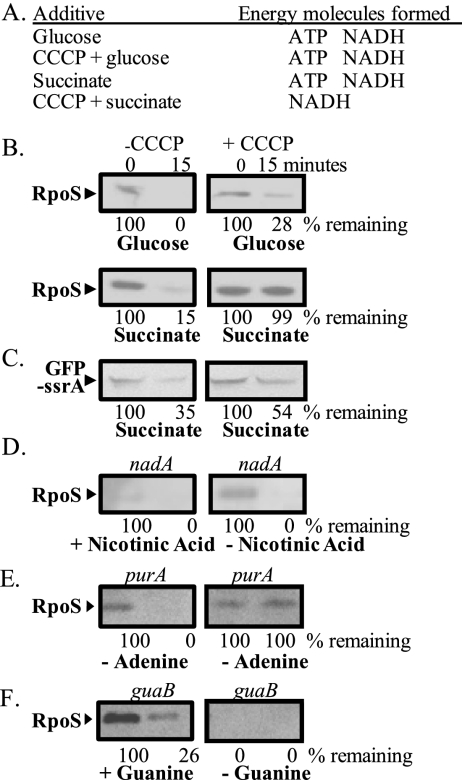Figure 2.
ATP is required to trigger RpoS degradation. (A) Summary of the energy molecules generated when either glucose or succinate is added to starved cells in the presence or absence of CCCP (an uncoupler that disrupts the proton motive force). (B) RpoS proteolysis is initiated when 0.4% glucose is added to starved cells, even in the presence of CCCP. Succinate (0.4%) can trigger RpoS degradation but not in presence of CCCP, when the NADH cannot be converted to ATP. Numbers below the Western blot are a quantification of the band intensity, normalized to 100% for the time = 0 samples. A representative gel from duplicate experiments is shown. Minutes refers to time passed after addition of carbon sources. (C) Degradation of another ClpXP substrate in low ATP conditions caused by the CCCP and succinate. Substrate GFP-ssrA degradation as monitored by Western blot after 0.4% succinate addition with and without CCCP. (D–F) Westerns are not from starvation experiments, but rather depletion experiments of essential components involved in either ATP or NADH biosynthesis. Cells were grown until mid-log stage in M63 supplemented with an essential component. They were washed twice, starved for the specific component, and treated with chloramphenicol. RpoS degradation was followed by Western blot. (D) RpoS degradation following a 2- h depletion of nicotinic acid, the precursor of NADH in nadA mutant strains. (E) RpoS degradation following a 1- h depletion of adenine, the precursor of ATP in purA mutant strains. (F) RpoS degradation following a 1-h depletion of guanine, the precursor to GTP in guaB mutant strains. Depletion of guanine in the guaB mutant strain leads to a sharp increase in ATP levels.

